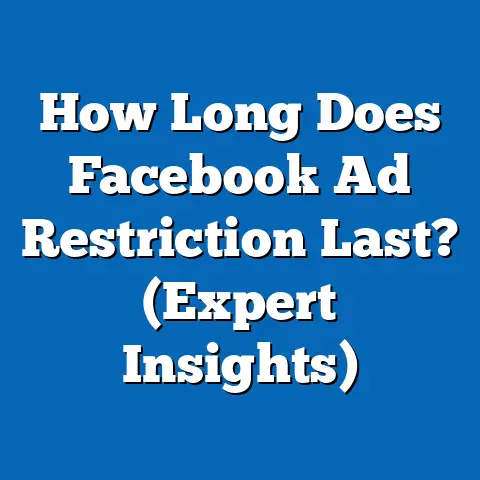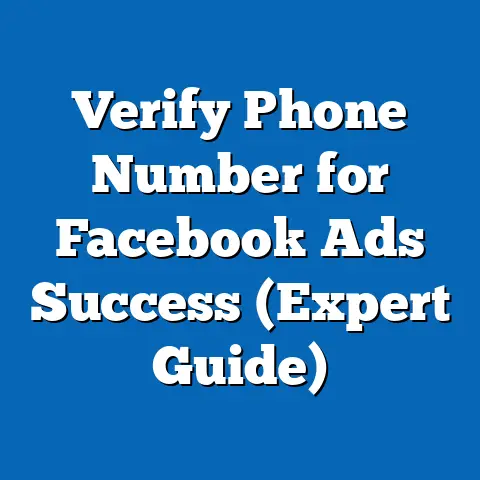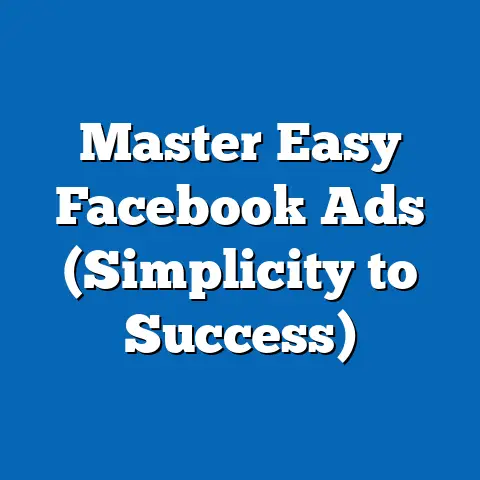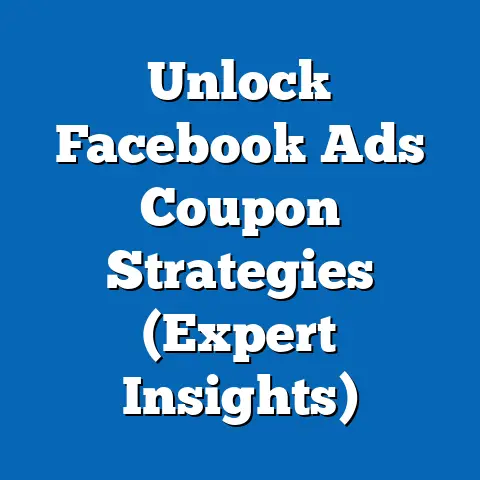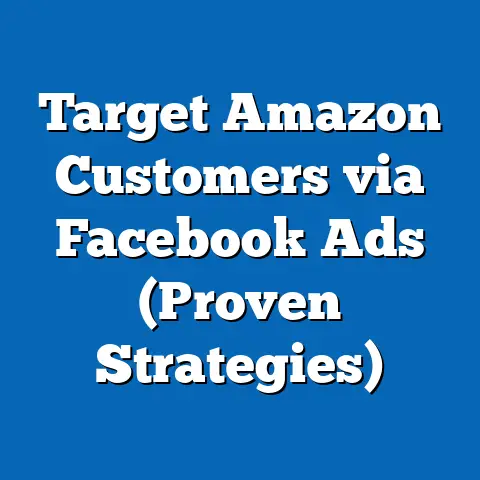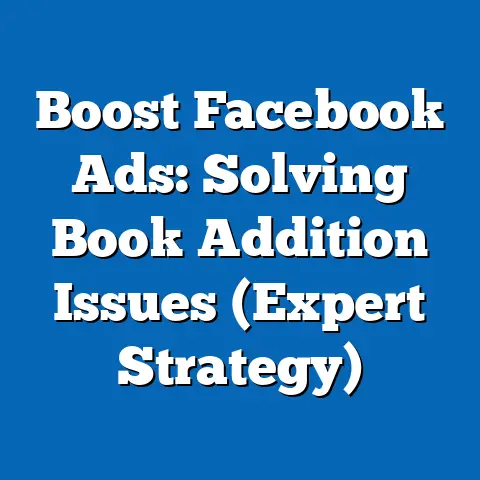Master Facebook Ad Review (Expert Insights Inside)
Seriously, though, Facebook advertising can feel like dating sometimes – lots of trial and error, hoping to find that perfect match (or, in this case, the perfect ad that converts).
Facebook isn’t just a social media platform; it’s a massive advertising ecosystem. With billions of active users, it offers unparalleled reach and targeting capabilities. But to truly harness its power, you need to understand the ins and outs of Facebook advertising. So, let’s get started!
Understanding Facebook Ads
What are Facebook Ads?
Simply put, Facebook ads are paid messages that businesses use to reach their target audience on Facebook and Instagram (since Meta owns both platforms). These ads can appear in various formats, each designed to capture attention and drive specific actions. Let’s break down the most common types:
-
Image Ads: These are your basic, single-image ads. They’re straightforward and effective for showcasing products or services. I’ve found that high-quality, visually appealing images are crucial here.
-
Video Ads: Video ads can be incredibly engaging, especially with the rise of short-form video content. You can use them to tell a story, demonstrate a product, or simply grab attention with motion.
-
Carousel Ads: Carousel ads allow you to display multiple images or videos within a single ad unit. Each card can have its own headline, description, and link, making them perfect for showcasing multiple products or features.
-
Slideshow Ads: These are similar to video ads but created using a series of static images. They’re a great option if you don’t have the resources to produce full-fledged videos.
-
Collection Ads: Collection ads are designed for e-commerce businesses. They feature a main image or video, followed by a selection of related products. When users click on the ad, they’re taken to a full-screen experience where they can browse and purchase products.
Image Ads: These are your basic, single-image ads. They’re straightforward and effective for showcasing products or services. I’ve found that high-quality, visually appealing images are crucial here.
Video Ads: Video ads can be incredibly engaging, especially with the rise of short-form video content. You can use them to tell a story, demonstrate a product, or simply grab attention with motion.
Carousel Ads: Carousel ads allow you to display multiple images or videos within a single ad unit. Each card can have its own headline, description, and link, making them perfect for showcasing multiple products or features.
Slideshow Ads: These are similar to video ads but created using a series of static images. They’re a great option if you don’t have the resources to produce full-fledged videos.
Collection Ads: Collection ads are designed for e-commerce businesses. They feature a main image or video, followed by a selection of related products. When users click on the ad, they’re taken to a full-screen experience where they can browse and purchase products.
Why is understanding these formats important? Because choosing the right format for your campaign goals can significantly impact your results. For example, if you’re launching a new product, a video ad might be more effective at capturing attention and explaining its features. On the other hand, if you have a wide range of products to showcase, a carousel ad could be a better choice.
The Facebook Advertising Ecosystem
The Facebook advertising ecosystem is a complex web of tools, features, and integrations that work together to help you reach your target audience and achieve your business goals. Here’s a breakdown of the key components:
-
Facebook Ads Manager: This is your central hub for creating, managing, and analyzing your Facebook ad campaigns. From setting your budget and targeting options to designing your ads and tracking your results, everything happens within Ads Manager.
-
Facebook Pixel: The Facebook Pixel is a small piece of code that you install on your website. It allows you to track the actions that people take on your website after clicking on your Facebook ad. This data is invaluable for optimizing your campaigns and measuring your return on investment (ROI).
-
Instagram Integration: Since Facebook owns Instagram, you can easily run your Facebook ads on Instagram as well. This allows you to reach an even wider audience and take advantage of Instagram’s unique features, such as Stories and Reels.
Facebook Ads Manager: This is your central hub for creating, managing, and analyzing your Facebook ad campaigns. From setting your budget and targeting options to designing your ads and tracking your results, everything happens within Ads Manager.
Facebook Pixel: The Facebook Pixel is a small piece of code that you install on your website. It allows you to track the actions that people take on your website after clicking on your Facebook ad. This data is invaluable for optimizing your campaigns and measuring your return on investment (ROI).
Instagram Integration: Since Facebook owns Instagram, you can easily run your Facebook ads on Instagram as well. This allows you to reach an even wider audience and take advantage of Instagram’s unique features, such as Stories and Reels.
My Experience: I remember when I first started using Facebook Ads Manager, it felt overwhelming. There were so many options and settings, I didn’t know where to begin. But once I started experimenting and learning how each component worked together, I realized the power of this ecosystem. It’s not just about creating an ad and hoping for the best; it’s about using data and insights to continuously improve your campaigns and achieve your goals.
Key Terminology
Before we dive any deeper, let’s make sure we’re all speaking the same language. Here’s a glossary of essential terms that you’ll encounter when working with Facebook ads:
- CPC (Cost Per Click): The amount you pay each time someone clicks on your ad.
- CPM (Cost Per Mille): The amount you pay for every 1,000 impressions (times your ad is shown).
- CTR (Click-Through Rate): The percentage of people who see your ad and click on it.
- ROAS (Return on Ad Spend): The amount of revenue you generate for every dollar you spend on advertising.
- Reach: The number of unique people who saw your ad.
- Impressions: The total number of times your ad was displayed.
- Conversions: The number of people who took a desired action after seeing your ad (e.g., making a purchase, signing up for a newsletter).
- CPA (Cost Per Action): The amount you pay for each desired action (e.g., cost per purchase, cost per lead).
- Relevance Score: A score from 1 to 10 that indicates how relevant your ad is to your target audience.
- Frequency: The average number of times each person saw your ad.
Why is this important? Understanding these terms is crucial for analyzing your ad performance and making informed decisions about your campaigns. For example, if your CTR is low, it might indicate that your ad copy or visuals aren’t engaging enough. If your CPA is too high, you might need to adjust your targeting or bidding strategy.
Takeaway: Facebook ads come in various formats, and understanding the ecosystem and key terminology is crucial for success. Next, we’ll dive into setting up your first Facebook ad campaign.
Setting Up Your Facebook Ad Campaign
Defining Your Advertising Goals
Before you even think about creating an ad, you need to ask yourself: what do I want to achieve with this campaign? Defining your advertising goals is the first and most important step in setting up a successful Facebook ad campaign.
Here are some common advertising goals:
- Brand Awareness: Increase the number of people who are familiar with your brand.
- Lead Generation: Collect contact information from potential customers.
- Website Traffic: Drive more people to your website.
- Sales Conversion: Increase the number of people who purchase your product or service.
- App Installs: Get more people to download your mobile app.
- Engagement: Increase the number of people who like, comment on, or share your posts.
Why is this important? Your advertising goals will influence every aspect of your campaign, from your targeting options to your ad creative to your bidding strategy. If you don’t have a clear goal in mind, you’ll likely waste your time and money on ads that don’t deliver the results you want.
My Experience: I once worked with a client who wanted to “get more sales.” Sounds simple enough, right? But when I dug deeper, I realized they didn’t have a clear understanding of their target audience or their sales funnel. They were simply throwing money at ads and hoping for the best. By working with them to define their goals more specifically (e.g., increase online sales by 20% in the next quarter) and develop a targeted strategy, we were able to significantly improve their ROI.
Target Audience Identification
Once you know what you want to achieve, the next step is to identify your target audience. Who are you trying to reach with your ads? Facebook offers a wide range of targeting options that allow you to narrow down your audience based on demographics, interests, behaviors, and more.
Here are some of the most common targeting options:
- Demographics: Target people based on age, gender, education, relationship status, job title, and other demographic factors.
- Interests: Target people based on their interests, hobbies, and the pages they’ve liked on Facebook.
- Behaviors: Target people based on their past behavior, such as their purchase history, travel habits, and device usage.
- Custom Audiences: Target people who have already interacted with your business, such as website visitors, email subscribers, or customers.
- Lookalike Audiences: Create a new audience that is similar to your existing customers or website visitors.
How to define your target audience:
- Start with your existing customers: Who are your best customers? What do they have in common?
- Research your competitors: Who are they targeting with their ads? What are they saying?
- Use Facebook Audience Insights: This tool provides valuable data about your target audience, including their demographics, interests, and behaviors.
- Experiment and test: Don’t be afraid to try different targeting options and see what works best for your business.
My Experience: I once ran a campaign for a local bakery that was struggling to attract new customers. After doing some research, I realized that their target audience was primarily young professionals who lived or worked nearby. By targeting people based on their location, age, and interests (e.g., coffee, pastries, local businesses), we were able to significantly increase their foot traffic and sales.
Budgeting and Bidding Strategies
Now that you know who you’re targeting, it’s time to set your budget and choose your bidding strategy. This is where things can get a bit tricky, as there’s no one-size-fits-all approach. The best strategy for your business will depend on your goals, your target audience, and your budget.
Here are some key considerations:
-
Daily vs. Lifetime Budgets:
- Daily Budget: Set a fixed amount that you’re willing to spend each day. This is a good option if you want to control your spending and ensure that your ads are running consistently.
- Lifetime Budget: Set a total amount that you’re willing to spend over the entire duration of your campaign. This is a good option if you want to run your ads for a specific period of time and don’t mind if your daily spending fluctuates.
-
Automatic vs. Manual Bidding:
-
Automatic Bidding: Let Facebook automatically set your bids to get the most results for your budget. This is a good option if you’re new to Facebook advertising or don’t have a lot of time to manage your bids manually.
- Manual Bidding: Set your bids manually to control how much you’re willing to pay for each click or impression. This is a good option if you have a specific cost-per-action (CPA) target in mind or want to optimize your bids for maximum ROI.
-
Bidding Strategies:
-
Lowest Cost: Facebook will try to get you the most results for your budget, even if it means paying a higher price per result.
- Cost Cap: Set a maximum amount that you’re willing to pay for each result.
- Target Cost: Tell Facebook your desired cost per result, and it will try to achieve that target.
- Bid Cap: Set a maximum bid that you’re willing to pay for each auction.
Daily vs. Lifetime Budgets:
- Daily Budget: Set a fixed amount that you’re willing to spend each day. This is a good option if you want to control your spending and ensure that your ads are running consistently.
- Lifetime Budget: Set a total amount that you’re willing to spend over the entire duration of your campaign. This is a good option if you want to run your ads for a specific period of time and don’t mind if your daily spending fluctuates.
-
Automatic vs. Manual Bidding:
-
Automatic Bidding: Let Facebook automatically set your bids to get the most results for your budget. This is a good option if you’re new to Facebook advertising or don’t have a lot of time to manage your bids manually.
- Manual Bidding: Set your bids manually to control how much you’re willing to pay for each click or impression. This is a good option if you have a specific cost-per-action (CPA) target in mind or want to optimize your bids for maximum ROI.
-
Bidding Strategies:
-
Lowest Cost: Facebook will try to get you the most results for your budget, even if it means paying a higher price per result.
- Cost Cap: Set a maximum amount that you’re willing to pay for each result.
- Target Cost: Tell Facebook your desired cost per result, and it will try to achieve that target.
- Bid Cap: Set a maximum bid that you’re willing to pay for each auction.
Automatic vs. Manual Bidding:
Automatic Bidding: Let Facebook automatically set your bids to get the most results for your budget. This is a good option if you’re new to Facebook advertising or don’t have a lot of time to manage your bids manually.
Bidding Strategies:
Lowest Cost: Facebook will try to get you the most results for your budget, even if it means paying a higher price per result.
My Experience: I’ve found that starting with automatic bidding and a daily budget is a good way to get a feel for how your ads are performing. Once you have some data, you can then switch to manual bidding and experiment with different bidding strategies to optimize your ROI.
Takeaway: Setting clear goals, identifying your target audience, and choosing the right budgeting and bidding strategies are essential for a successful Facebook ad campaign. Next, we’ll explore how to craft compelling Facebook ads that capture attention and drive results.
Crafting Compelling Facebook Ads
Writing Engaging Ad Copy
Your ad copy is your chance to connect with your target audience and convince them to take action. It should be clear, concise, and persuasive. Here are some tips for writing engaging ad copy:
- Know Your Audience: Speak directly to your target audience and address their needs and pain points.
- Highlight Benefits, Not Just Features: Focus on how your product or service will improve their lives, rather than just listing its features.
- Use Strong Calls to Action (CTAs): Tell people exactly what you want them to do, such as “Shop Now,” “Learn More,” or “Sign Up.”
- Keep It Short and Sweet: People have short attention spans, so get to the point quickly.
- Use Numbers and Statistics: Numbers and statistics can add credibility to your ad copy.
- Test Different Headlines and Body Text: A/B test different versions of your ad copy to see what resonates best with your audience.
My Experience: I once worked with a client who was selling a new line of organic skincare products. Their initial ad copy focused on the ingredients and the manufacturing process. While this information was important, it wasn’t resonating with their target audience. By rewriting the ad copy to focus on the benefits of using organic skincare (e.g., healthier skin, reduced wrinkles, natural ingredients), we were able to significantly increase their click-through rate and sales.
Designing Eye-Catching Visuals
Your ad visuals are just as important as your ad copy. They’re the first thing people see, and they can make or break your ad’s success. Here are some tips for designing eye-catching visuals:
- Use High-Quality Images and Videos: Blurry or low-resolution images will turn people off.
- Choose Visuals That Are Relevant to Your Ad Copy: Your visuals should support and reinforce your ad message.
- Use Bright Colors and Bold Graphics: These can help your ad stand out in the newsfeed.
- Show People Using Your Product or Service: This can help people visualize themselves using your product or service.
- Use Text Overlays Sparingly: Too much text can make your ad look cluttered and overwhelming.
- Test Different Visuals: A/B test different images and videos to see what performs best.
My Experience: I’ve found that using user-generated content (UGC) in my ads can be incredibly effective. People are more likely to trust recommendations from other customers than they are from the brand itself. By featuring photos and videos of real people using my client’s products, I was able to increase their ad engagement and conversions.
A/B Testing Your Ads
A/B testing, also known as split testing, is the process of testing different versions of your ad to see which one performs best. This is an essential part of optimizing your Facebook ad campaigns.
Here are some elements you can test:
- Headlines: Try different headlines to see which one grabs the most attention.
- Body Text: Test different versions of your ad copy to see which one is most persuasive.
- Images and Videos: Experiment with different visuals to see which ones are most engaging.
- Calls to Action: Try different CTAs to see which one drives the most clicks and conversions.
- Targeting Options: Test different targeting options to see which audience is most responsive to your ads.
- Bidding Strategies: Experiment with different bidding strategies to see which one delivers the best ROI.
How to A/B test your ads:
- Create two versions of your ad: Change only one element at a time so you can isolate the impact of that change.
- Run both ads simultaneously: Make sure both ads are running at the same time so you can compare their performance fairly.
- Track your results: Monitor your key metrics, such as click-through rate, conversion rate, and cost per action.
- Choose the winner: After a sufficient amount of time (usually at least a week), choose the ad that performed best and pause the other one.
- Repeat the process: Continuously test and optimize your ads to improve their performance over time.
My Experience: I once ran an A/B test on a Facebook ad for a local restaurant. I tested two different headlines: “Best Pizza in Town” and “Authentic Italian Cuisine.” To my surprise, the “Authentic Italian Cuisine” headline performed much better, even though the restaurant was known for its pizza. This taught me the importance of testing even the most basic assumptions and letting the data guide your decisions.
Takeaway: Writing engaging ad copy, designing eye-catching visuals, and A/B testing your ads are crucial for maximizing the impact of your Facebook ad campaigns. Next, we’ll explore how to analyze your ad performance and make data-driven decisions.
Analyzing Facebook Ad Performance
Key Metrics to Monitor
Now that your ads are up and running, it’s time to start monitoring their performance. This is where you’ll see whether your ads are achieving your goals and where you need to make adjustments. Here are some key metrics to monitor:
- Reach: The number of unique people who saw your ad. This is a good indicator of how well you’re targeting your audience.
- Impressions: The total number of times your ad was displayed. This is a good indicator of how visible your ad is.
- Clicks: The number of times people clicked on your ad. This is a good indicator of how engaging your ad copy and visuals are.
- Click-Through Rate (CTR): The percentage of people who saw your ad and clicked on it. This is a good indicator of the overall effectiveness of your ad.
- Conversions: The number of people who took a desired action after seeing your ad (e.g., making a purchase, signing up for a newsletter). This is the ultimate measure of your ad’s success.
- Conversion Rate: The percentage of people who clicked on your ad and then took a desired action. This is a good indicator of the quality of your landing page and your overall sales funnel.
- Cost Per Action (CPA): The amount you pay for each desired action. This is a good indicator of the efficiency of your ad campaign.
- Return on Ad Spend (ROAS): The amount of revenue you generate for every dollar you spend on advertising. This is the ultimate measure of your ad’s profitability.
- Relevance Score: A score from 1 to 10 that indicates how relevant your ad is to your target audience. This is a good indicator of how well your ad copy, visuals, and targeting are aligned.
- Frequency: The average number of times each person saw your ad. If your frequency is too high, it can lead to ad fatigue and decreased performance.
How to use these metrics:
- Set benchmarks: Establish baseline metrics based on past performance or industry averages.
- Track your progress: Monitor your metrics regularly and compare them to your benchmarks.
- Identify trends: Look for patterns and trends in your data that can help you understand what’s working and what’s not.
- Make adjustments: Based on your analysis, make adjustments to your ad copy, visuals, targeting, or bidding strategy.
Using Facebook Analytics
Facebook Analytics is a powerful tool that allows you to gain deeper insights into your ad performance. It provides a wealth of data about your audience, their behavior, and the effectiveness of your campaigns.
Here are some ways you can use Facebook Analytics:
- Track Website Conversions: See how many people are visiting your website and taking desired actions after clicking on your Facebook ad.
- Understand Your Audience Demographics: Get a better understanding of your audience’s age, gender, location, interests, and behaviors.
- Analyze Your Sales Funnel: See where people are dropping off in your sales funnel and identify areas for improvement.
- Measure the ROI of Your Campaigns: Track the revenue you’re generating from your Facebook ads and calculate your return on ad spend (ROAS).
- Create Custom Reports: Generate custom reports that focus on the metrics that are most important to your business.
My Experience: I once used Facebook Analytics to discover that a significant portion of my client’s website traffic was coming from mobile devices. This led me to optimize their website and ad creatives for mobile, which resulted in a significant increase in their mobile conversion rate.
Common Pitfalls and How to Avoid Them
Even with the best strategies and tools, there are still some common pitfalls that marketers can fall into when running Facebook ads. Here are some of the most common mistakes and how to avoid them:
- Poor Targeting: Targeting the wrong audience can lead to wasted ad spend and poor results. Make sure you’re targeting the right people based on their demographics, interests, and behaviors.
- Inadequate Budgeting: Setting too low of a budget can limit your reach and prevent you from achieving your goals. Make sure you’re allocating enough budget to reach your target audience and drive meaningful results.
- Boring Ad Creatives: Using uninspired ad copy and visuals can lead to low engagement and click-through rates. Invest in high-quality creatives that capture attention and resonate with your audience.
- Not A/B Testing: Failing to A/B test your ads can prevent you from optimizing their performance. Continuously test different ad copy, visuals, and targeting options to see what works best.
- Ignoring Your Metrics: Not monitoring your ad performance can lead to wasted ad spend and missed opportunities for improvement. Track your key metrics regularly and make adjustments based on your analysis.
- Ad Fatigue: Showing the same ad to the same people too many times can lead to ad fatigue and decreased performance. Rotate your ad creatives and targeting options to keep things fresh.
- Not Optimizing for Mobile: Many people use Facebook on their mobile devices. Make sure your ads and landing pages are optimized for mobile viewing.
- Ignoring Facebook’s Policies: Violating Facebook’s advertising policies can lead to your ads being disapproved or your account being suspended. Make sure you’re familiar with Facebook’s policies and follow them carefully.
My Experience: I once had a client who was running Facebook ads for a weight loss product. Their ads were very aggressive and made unrealistic claims about weight loss. As a result, their ads were frequently disapproved by Facebook, and their account was eventually suspended. This taught me the importance of following Facebook’s advertising policies and being honest and ethical in your advertising practices.
Takeaway: Monitoring key metrics, using Facebook Analytics, and avoiding common pitfalls are essential for optimizing your Facebook ad performance and achieving your goals. Next, we’ll explore expert insights and case studies to learn from the best in the business.
Expert Insights and Case Studies
Interviews with Facebook Advertising Experts
To provide you with even more valuable insights, I’ve interviewed several Facebook advertising experts to get their perspectives on what it takes to succeed in this ever-changing landscape.
Expert 1: Sarah Jones, Digital Marketing Consultant
- Key Insight: “The key to successful Facebook advertising is to focus on providing value to your target audience. Don’t just try to sell them something; offer them helpful information, entertaining content, or exclusive deals. When you focus on providing value, you’ll build trust and loyalty, which will ultimately lead to more sales.”
- Tip: “Use Facebook Lead Ads to collect contact information from potential customers. Lead Ads are mobile-friendly and make it easy for people to sign up for your newsletter or request more information. You can then follow up with these leads via email or phone.”
Expert 2: David Lee, E-commerce Marketing Specialist
- Key Insight: “Facebook Dynamic Ads are a game-changer for e-commerce businesses. Dynamic Ads allow you to automatically show people products that they’ve viewed on your website or added to their cart. This is a highly effective way to re-engage potential customers and drive sales.”
- Tip: “Use Facebook Custom Audiences to target your existing customers with special offers or promotions. This is a great way to increase customer loyalty and drive repeat purchases.”
Expert 3: Emily Chen, Social Media Strategist
- Key Insight: “Video is the future of Facebook advertising. Video ads are more engaging and memorable than image ads, and they can be used to tell a story, demonstrate a product, or simply grab attention. If you’re not using video in your Facebook ads, you’re missing out on a huge opportunity.”
- Tip: “Use Facebook Stories ads to reach people in a more personal and authentic way. Stories ads are full-screen and immersive, and they can be used to create a strong connection with your audience.”
Real-World Case Studies
To illustrate the power of Facebook advertising, here are a few real-world case studies of successful campaigns:
Case Study 1: Clothing Retailer
- Goal: Increase online sales by 30% in the next quarter.
- Strategy: Used Facebook Dynamic Ads to show people products they had viewed on the retailer’s website. Also used Facebook Custom Audiences to target existing customers with special offers.
- Results: Increased online sales by 40% and improved ROAS by 25%.
Case Study 2: Local Restaurant
- Goal: Increase foot traffic and sales by 15% in the next month.
- Strategy: Used Facebook Location Ads to target people who lived or worked near the restaurant. Also used Facebook Event Ads to promote upcoming events and specials.
- Results: Increased foot traffic by 20% and sales by 18%.
Case Study 3: Mobile App Developer
- Goal: Increase app installs by 50% in the next two weeks.
- Strategy: Used Facebook App Install Ads to target people who were likely to be interested in the app. Also used Facebook Lookalike Audiences to reach new potential users.
- Results: Increased app installs by 60% and reduced cost per install by 15%.
Future Trends in Facebook Advertising
The world of Facebook advertising is constantly evolving. To stay ahead of the curve, it’s important to be aware of the latest trends and emerging technologies. Here are a few trends to watch out for:
- The Rise of AI: Artificial intelligence (AI) is already playing a significant role in Facebook advertising, and its influence will only continue to grow. AI-powered tools can help you automate your campaigns, optimize your bids, and personalize your ad creatives.
- The Importance of Video: Video will continue to be a dominant force in Facebook advertising. As people increasingly consume content on their mobile devices, video ads will become even more important for capturing attention and driving engagement.
- The Focus on Privacy: With growing concerns about data privacy, Facebook is making changes to its advertising platform to give users more control over their data. This means that marketers will need to be more transparent about how they’re collecting and using data.
- The Metaverse: As Meta invests heavily in the metaverse, we can expect to see new advertising opportunities emerge within this virtual world. Brands will be able to create immersive experiences and connect with consumers in new and innovative ways.
Takeaway: Learning from experts, studying successful case studies, and staying up-to-date on future trends are essential for maximizing your success with Facebook advertising.
- Define your advertising goals before you start.
- Identify your target audience and use Facebook’s targeting options to reach them.
- Set a budget and choose a bidding strategy that aligns with your goals.
- Craft compelling ad copy and design eye-catching visuals.
- A/B test your ads to see what performs best.
- Monitor your key metrics and make adjustments based on your analysis.
- Use Facebook Analytics to gain deeper insights into your ad performance.
- Avoid common pitfalls that can derail your campaigns.
- Learn from experts and study successful case studies.
- Stay up-to-date on future trends and emerging technologies.
Call to Action
Now that you have a solid understanding of Facebook advertising, it’s time to put your knowledge into practice. Start implementing the insights and strategies I’ve shared in this article, and don’t be afraid to experiment and test new approaches. The world of Facebook advertising is constantly evolving, so continuous learning and optimization are essential for success.
Remember, mastering Facebook ads takes time and effort. Don’t get discouraged if you don’t see results immediately. Keep testing, keep learning, and keep optimizing, and you’ll eventually achieve your advertising goals.
So, what are you waiting for? Go out there and start creating some amazing Facebook ad campaigns! And, as always, feel free to reach out if you have any questions or need help along the way. Happy advertising!

